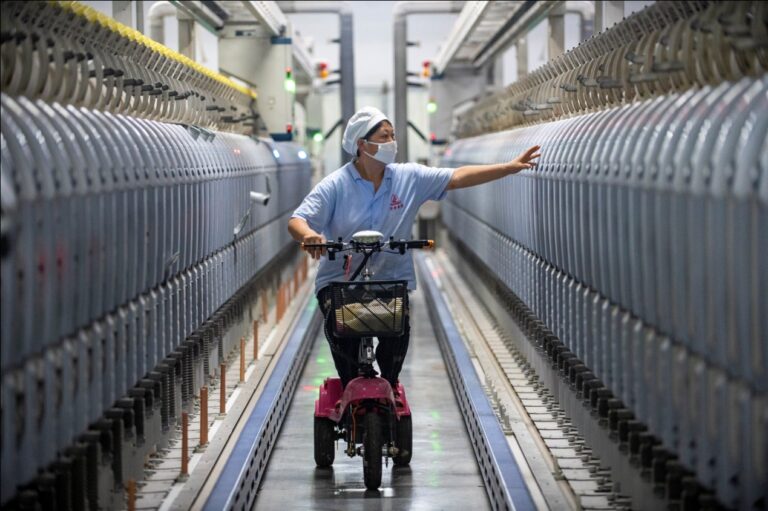
By Dou Hanyang, People’s Daily
Thanks to a new amendment to China’s Patent Law that entered into force on June 1, 2021, patents in the country that have lain idle can be put into actual use easier.
Wu Zhenyu, a professor with the School of Mechanical Engineering and Automation, Zhejiang Sci-Tech University, is one of the patent owners who have benefited from the new amendment, which introduces an open licensing system to facilitate the utilization of patents.
Wu owns a patent on an invention that can be useful to companies in the mechatronics engineering field. However, the invention patent had been idle since it was approved in 2017.
“I wanted my invention to be applied, but I failed to find suitable companies that can use it,” Wu said, adding that the idea of putting the patent into use was later shelved as he was busy with teaching.
Fortunately, the open licensing system introduced by the amended Patent Law has brought new opportunities to idle patents like the one owned by Wu. The new Patent Law also stipulates that during the implementation period of the open license, the annual fee paid by the patentee shall be reduced or exempted accordingly.
Open licensing of patents refers to a type of patent licensing in which the holder of a patent makes an offer through patent management authority to license any entity or individual to exploit the patent, and any potential licensee that accepts the offer can be licensed to implement the patent.
Open licensing systems for patents can facilitate communication between patent holders and potential licensees. The patent gazettes published by the patent management authority serve as a bridge for communication between the patentee and licensee.
Besides, by enabling the supplier and potential user of a patent to reach an agreement on the authorization to exploit the patent in a simple and convenient way, the open licensing system saves both parties from complex negotiations, thus improving the efficiency of their communication.
Moreover, through its mechanisms for patent licensing-related information disclosure and patent right-related dispute resolution, the system allows potential licensees to get a full understanding of requirements for and relevant information about the granting of patent rights before accepting an offer, and in this way reduces risks in deal on the exploitation of an open-licensed patent.
East China’s Zhejiang province took the lead in the country to pilot the open licensing system. In August 2021, the Zhejiang provincial bureau of market regulation published an announcement on soliciting patents available for exploitation under an open license. As of the end of last year, the authority received applications from 14 universities, colleges, and scientific research institutes in the province, and all the 379 patients they offered met the requirements for entering the system.
As the endeavor has been vigorously advanced, Wu’s patent soon caught the attention of a textile machinery manufacturer based in Huzhou city, Zhejiang province.
In recent years, the company has put great efforts into the development of new equipment, but didn’t make any major progress, said Ni Zhiqi, an executive of the company.
“After contacting Professor Wu, we found that the device covered by his patent can effectively solve the problems we face by directly replacing the warp rack of our existing looms,” Ni said.
The company and Wu quickly reached an agreement on the exploitation of the patent, and are currently jointly developing a new machine.
“It’s estimated that my patent can bring a 30-percent increase in the annual output value of the company,” said Wu, who is satisfied with the prospect that his patent will be translated into tangible results.
In 2020, 34.7 percent of China’s effective invention patents had been put into industrial application, according to a survey issued by the National Intellectual Property Administration last year.
The survey revealed that 44.9 percent of the invention patents owned by enterprises had been actually used in industrial application scenarios in 2020, while the percentages of invention patents, in industrial use, owned by scientific research institutes and universities and colleges stood at 11.3 percent and 3.8 percent, respectively.
It’s evident that there was a significant gap between universities and colleges and enterprises in terms of the industrial application of effective patents, pointed out Lin Min, an official with the Zhejiang provincial bureau of market regulation.
“Many valuable invention patents of universities and colleges lacked the opportunity to play a part, while micro, small and medium-sized firms which need to use these patents couldn’t find an effective way to cooperate with their holders,” Lin said.
Such problems have been gradually solved since Zhejiang explored the implementation of the open licensing system for patents. More and more patents that used to lie idle on the shelves in universities, colleges, and scientific research institutes in the province are now playing important roles in the production of micro, small and medium-sized firms. So far, a total of 118 patent exploitation-related projects have been signed between universities and colleges in Zhejiang and enterprises in the province.
According to a preferential policy rolled out by Zhejiang province, enterprises that apply to be licensed to exploit the first 379 open-licensed patents won’t be charged a fee for the licensing during the implementation period of the open license.
The term of a single license ranges between one year and five years, which can make sure that the companies which obtain the license can have sufficient time to conduct research and development and test products based on the open-licensed patent and eventually launch new products.
“In the long run, open licensing of patents for free can help sci-tech achievements of universities and colleges promote the development of industries,” said Yang Xiaogang, an official with Zhejiang Sci-Tech University.
It can also make licensing negotiations easier, reduce the cost of the industrial application of patents owned by colleges and universities, and facilitate the innovative development of more micro, small and medium-sized firms, according to Yang.










